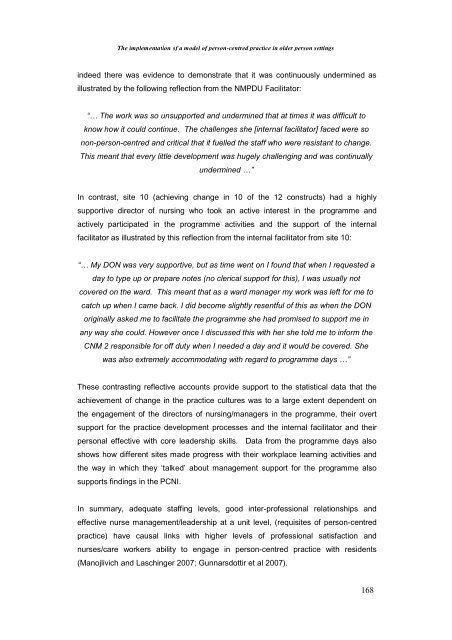The Implementation of a Model of Person-Centred Practice In Older ...
The Implementation of a Model of Person-Centred Practice In Older ...
The Implementation of a Model of Person-Centred Practice In Older ...
Create successful ePaper yourself
Turn your PDF publications into a flip-book with our unique Google optimized e-Paper software.
<strong>The</strong> implementation <strong>of</strong> a model <strong>of</strong> person-centred practice in older person settings<br />
indeed there was evidence to demonstrate that it was continuously undermined as<br />
illustrated by the following reflection from the NMPDU Facilitator:<br />
“… <strong>The</strong> work was so unsupported and undermined that at times it was difficult to<br />
know how it could continue. <strong>The</strong> challenges she [internal facilitator] faced were so<br />
non-person-centred and critical that it fuelled the staff who were resistant to change.<br />
This meant that every little development was hugely challenging and was continually<br />
undermined …”<br />
<strong>In</strong> contrast, site 10 (achieving change in 10 <strong>of</strong> the 12 constructs) had a highly<br />
supportive director <strong>of</strong> nursing who took an active interest in the programme and<br />
actively participated in the programme activities and the support <strong>of</strong> the internal<br />
facilitator as illustrated by this reflection from the internal facilitator from site 10:<br />
“… My DON was very supportive, but as time went on I found that when I requested a<br />
day to type up or prepare notes (no clerical support for this), I was usually not<br />
covered on the ward. This meant that as a ward manager my work was left for me to<br />
catch up when I came back. I did become slightly resentful <strong>of</strong> this as when the DON<br />
originally asked me to facilitate the programme she had promised to support me in<br />
any way she could. However once I discussed this with her she told me to inform the<br />
CNM 2 responsible for <strong>of</strong>f duty when I needed a day and it would be covered. She<br />
was also extremely accommodating with regard to programme days …”<br />
<strong>The</strong>se contrasting reflective accounts provide support to the statistical data that the<br />
achievement <strong>of</strong> change in the practice cultures was to a large extent dependent on<br />
the engagement <strong>of</strong> the directors <strong>of</strong> nursing/managers in the programme, their overt<br />
support for the practice development processes and the internal facilitator and their<br />
personal effective with core leadership skills. Data from the programme days also<br />
shows how different sites made progress with their workplace learning activities and<br />
the way in which they ‘talked’ about management support for the programme also<br />
supports findings in the PCNI.<br />
<strong>In</strong> summary, adequate staffing levels, good inter-pr<strong>of</strong>essional relationships and<br />
effective nurse management/leadership at a unit level, (requisites <strong>of</strong> person-centred<br />
practice) have causal links with higher levels <strong>of</strong> pr<strong>of</strong>essional satisfaction and<br />
nurses/care workers ability to engage in person-centred practice with residents<br />
(Manojlivich and Laschinger 2007; Gunnarsdottir et al 2007).<br />
168
















